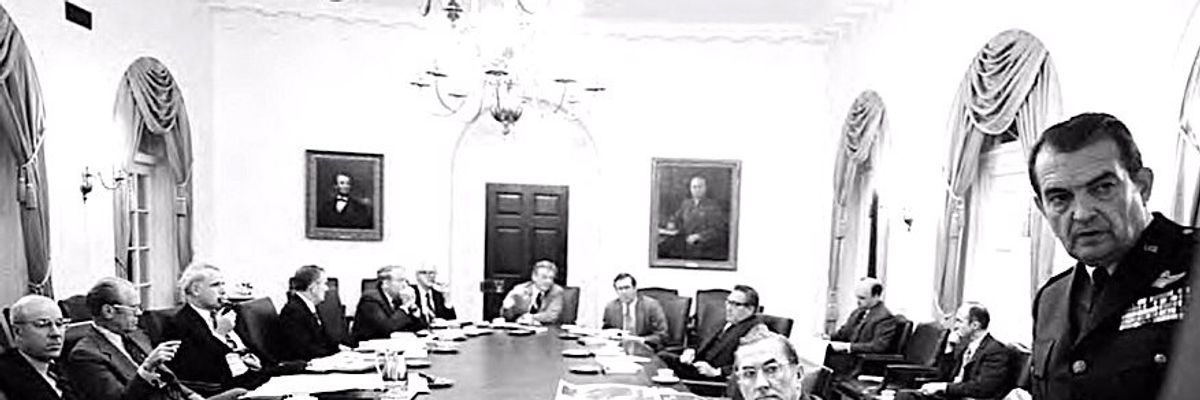Largely unnoticed in the rush of the moment was the recently issued White House Interim National Security Strategic Guidance document. Tucked in there were two related presidential National Security Memoranda that preceded this interim guidance document.
NSM 2, “Renewing the National Security Council System,” warrants particular notice because of an especially noteworthy passage in the interim guidance document:
Because traditional distinctions between foreign and domestic policy – and among national security, economic security, health security, and environmental security – are less meaningful than ever before, we will reform and rethink our agencies, departments, interagency processes, and White House organization to reflect this new reality. . . . [W]e will develop new mechanisms to coordinate policy and implementation across this diverse set of stakeholders.
Evincing a richer, more encompassing conception of national security than it inherited, the Biden administration thus promises to reform the organizational structure for conducting national security affairs. By so doing, it tacitly acknowledges the link between how we organize and how we think. At any given point in time, the thinking of some cohort of influencers affects the form of organization they choose for conducting the affairs of state; thereafter, though, this organizational arrangement affects — and may even dictate — how the community at large thinks about such matters.
The quintessential example of this is the 1947 National Security Act which didn’t define national security but rather established an organizational structure that effectively prefigured how we think about national security to this day. Absent some catastrophic circumstance — like 9/11 — that would force a reorientation in how we think, reorganizing is the necessary precondition for rethinking.
NSM 2 follows in the bureaucratic footsteps of every presidential administration from Truman on by laying out, in an early presidential directive, the structure of the national security apparatus. As its title suggests — “Renewing the National Security Council System,” rather than the more standard “Organization for National Security” — it opts for reassurance over innovation. The Biden NSC, like its predecessors, includes the long-standing statutory members — the President and Vice President and the Secretaries of State and Defense. It also includes the more recently added statutory members – the Secretaries of Energy and Treasury – along with seven other senior officials of the President’s choosing. The Director of National Intelligence and the Chairman of the Joint Chiefs of Staff remain statutory advisers. Aside from then describing the NSC’s supporting substructure — a Principals Committee, a Deputies Committee, and various yet-to-be-identified Interagency Policy Committees —NSM 2 offers no additional ideas for other organizational enterprises that might constitute the larger national security apparatus.
Given this essentially traditional arrangement, the bottom-line question is whether the Biden national security team gives any evidence as yet of transformative, legacy-setting organizational reforms implied in the administration’s interim strategic guidance document. For now, the answer is no. But we can still hope.
Organizing is, of course, a classical function of management. We organize to get things done; to establish rationality and order in our social interactions; to apportion work, responsibility, authority, prerogatives, and resources. But, as importantly, we also organize to project imagery based on how we label organizations and where we place them. Why else would we turn the Veterans Administration into a cabinet-level Department of Veterans Affairs or call the Pentagon the Department of Defense rather than the Department of War or the Department of Peace? Why, conversely, would we relegate the federal government’s lead environmental arm to the status of a second-tier agency, rather than according it ministerial-level status, as many other countries do? Why would we rob the Arms Control and Disarmament Agency and the U.S. Information Agency of their independent identities and status and bury them inside the State Department? Why would we establish a domestic “combatant command” called the U.S. Northern Command?
Presumably, the Biden administration understands all of this. So, let’s ask ourselves how transformative the administration seems likely to be — how much “institutional leapfrogging,” in other words, it might be inclined to take on as an enduring legacy for the future.
NSM 2, in line with the National Security Act, reaffirms that the very purpose of the NSC is to integrate all facets of national security policy (domestic, foreign, and military). In the interest, then, of higher-order, unifying integration, let’s consider a completely revamped NSC consisting of six statutory members only: the President and Vice President, the Permanent Representative to the United Nations (to unconditionally affirm our commitment to that institution), and three new supra-Cabinet ministers: one for international affairs (to oversee and direct State, Defense, the Intelligence Community, etc.); one for domestic affairs (to oversee and direct the likes of Justice, Health and Human Services, Housing and Urban Development, Interior, etc.), and one for national resources (a mobilization-ready reconstitution of the National Security Resources Board originally provided for in the National Security Act, that would oversee and direct the likes of Treasury, Labor, Transportation, a newly merged Department of Energy and Environment, etc.)?
Why do something so dramatic? Strategically, to underscore our commitment to international institutions, achieve an elevated level of integrated unity (capital J, interagency Jointness), and present a more coherent conception of national security (international, domestic, and resource-directed). Politically, we would want to concentrate accountability in a reduced number of “chiefs” and institutionalize statutory membership across administrations rather than conceding to the ad hoc, idiosyncratic approach that has prevailed to date. Managerially, there is a desire to streamline NSC membership and reduce span of control.
Let’s up the ante yet again. In the interest of subordinating the military to diplomatic, development, and economic instruments of national power, as the interim strategy guidance document promises, let’s redesignate the Chairman of the Joint Chiefs of Staff the Chief of Military Staff, while relinquishing the position’s statutory advisory role to the NSC. Let’s convert the Joint Chiefs of Staff, comprised of the armed services chiefs responsible only for administratively organizing, training, and equipping, into a Council of Military Commanders, comprised of the operational commanders who actually employ forces in the field. Rather than perpetuating the militaristic label of combatant commands, they would be redesignated unified and specified commands as they were traditionally known. While we’re at it, we could eliminate the U.S. Northern Command in the interest of demilitarizing the homefront and, in light of other moves, also eliminate the civilian armed services secretariats.
What “other moves” are we talking about? If we were to establish regional super-ambassadors in each region of the world, we could serve the conjoined purposes of reasserting civilian supremacy over the military in the field, demonstrating a diplomacy-based regional (rather than country-specific) orientation, thereby superseding the erstwhile combatant command “proconsuls,” and providing the basis for a new Council of Chief Diplomats to advise the Secretary of State in a manner analogous to the Council of Military Commanders.
This, combined with making the Secretary of Defense (as the President’s sole National Command Authority counterpart) the sole Defense “voice” answering to the Minister for International Affairs, would make the highly politicized civilian armed services secretariats, whose role in exercising civilian control of the military is marginal at best, superfluous bureaucratic baggage that could be easily jettisoned.
All in all, these measures would diminish the dominant role of the military as a preferred instrumentality, fundamentally demilitarize our strategic posture at home and abroad, and greatly enhance little-j military jointness in the interest of turning what has come to be called “globally integrated operations” into a strategic reality, not just a bureaucratic public relations device.
“We think our civilization near its meridian,” said Ralph Waldo Emerson, “but we are yet only at the cock-crowing and the morning star.” So, too, is this the case in the evolution of our institutions of statecraft. The suggestions proffered here, but an abbreviated few of many others that might be suggested, are themselves at the cock crowing and morning star of possibilities for dramatic transformation. If the Biden administration is to live up to its promise and its promises, it would do well to seriously consider such proposals, however heterodox, and we the citizenry would ultimately be well served by the attendant legacy.
















